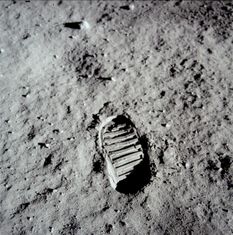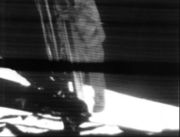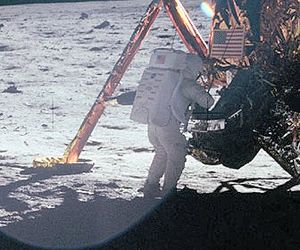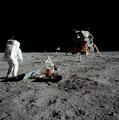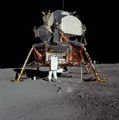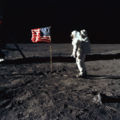Apollo 11
2007 Schools Wikipedia Selection. Related subjects: Space transport
| Mission insignia | |||||
|---|---|---|---|---|---|
 |
|||||
| Mission statistics | |||||
| Mission name: | Apollo 11 | ||||
| Call sign: | Command module: Columbia Lunar module: Eagle |
||||
| Number of crew members: | 3 | ||||
| Launch pad: | Kennedy Space Centre, Florida LC 39A |
||||
| Launch: | July 16, 1969 13:32:00 UTC |
||||
| Lunar landing: | July 20, 1969 20:17:40 UTC Sea of Tranquility 0° 40' 26.69" N, 23° 28' 22.69" E (based on the IAU Mean Earth Polar Axis coordinate system) |
||||
| Lunar EVA length: | 2 h 31 min 40 s | ||||
| Lunar surface time: | 21 h 36 min 20 s | ||||
| Lunar sample mass: | 21.55 kg (47.5 lb) | ||||
| Landing: | July 24, 1969 16:50:35 UTC |
||||
| Duration: | 195 h 18 min 35 s | ||||
| Time in lunar orbit: | 59 h 30 min 25.79 s | ||||
| Mass: | CSM: 30,320 kg LM: 16,448 kg |
||||
| Crew photo | |||||
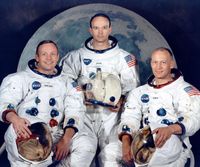 L-R: Armstrong, Collins and Aldrin |
|||||
| Navigation | |||||
|
|||||
Apollo 11 was the first manned mission to land on the Moon. It was the fifth human spaceflight of the Apollo program, and the third human voyage to the moon. Launched on July 16, 1969, it carried Commander Neil Armstrong, Command Module Pilot Michael Collins and Lunar Module Pilot Edwin 'Buzz' Aldrin. On July 20, Armstrong and Aldrin became the first humans to land on the Moon, while Collins orbited above.
The mission fulfilled President John F. Kennedy's goal of "landing a man on the moon and returning him safely to the Earth" by the end of the 1960s.
Crew
Primary crew
- Neil Armstrong (2), commander
- Michael Collins (2), command module pilot
- Edwin 'Buzz' Aldrin (2), lunar module pilot
*Number in parentheses indicates number of spaceflights by each individual prior to and including this mission.
Backup crew
- James Lovell (flew in Gemini 7, Gemini 12, Apollo 8, Apollo 13), commander
- Bill Anders (flew in Apollo 8), command module pilot
- Fred Haise (flew in Apollo 13), lunar module pilot
Support crew
- Charles Moss Duke, Jr., Capsule Communicator (CAPCOM)
- Ronald Evans, CAPCOM
- Owen K. Garriott, CAPCOM
- Don L. Lind, CAPCOM
- Ken Mattingly, CAPCOM
- Bruce McCandless II, CAPCOM
- Harrison Schmitt, CAPCOM
- Bill Pogue
- Jack Swigert
Flight directors
- Clifford E. Charlesworth, Lead Flight Director, Green team
- Gerald D. Griffin, Gold team
- Gene Kranz, White team
- Glynn S. Lunney, Black team
Mission highlights
Launch and lunar landing
In addition to one million people crowding the highways and beaches near the launch site, an estimated audience of over 600 million people viewed the event on television; a new record at that time. President Nixon viewed the proceedings from the Oval Office of the White House.
Apollo 11 was launched by a Saturn V from the Kennedy Space Centre on July 16, 1969 at 13:32 UTC (9:32 A.M. local time). It entered Earth's orbit 12 minutes later. After one and a half orbits, the S-IVB third-stage engine pushed the spacecraft onto its trajectory toward the Moon. About 30 minutes later, the command/service module pair separated from the last remaining Saturn V stage, and docked with the lunar module still nestled in the Lunar Module Adaptor. A translunar injection burn (TLI) then launched the combined spacecraft towards the moon.
Apollo 11 passed behind the Moon on July 19 and fired its Service propulsion engine in order to enter lunar orbit. In the several orbits that followed, the crew got passing views of their landing site. In the southern Sea of Tranquility about 20 km (12 mi) southwest of the crater Sabine D (0.67408N,23.47297E), the landing site was selected in part because it had been characterized as relatively flat and smooth by the automated Ranger 8 and Surveyor 5 landers, as well as by Lunar Orbiter mapping spacecraft. It was therefore unlikely to present major landing or extra-vehicular activity (EVA) challenges.
On July 20, 1969, while on the far side of the Moon, the lunar module, called Eagle after the eagle present on the insignia, separated from the Command Module, named Columbia after the columbiad cannon used to launch moonships in Jules Verne's novel From the Earth to the Moon. Some internal NASA planning documents referred to the callsigns as Snowcone and Haystack; these were quietly changed before being announced to the press. Collins, alone aboard Columbia, inspected Eagle as it pirouetted before him to ensure the craft was not damaged. Armstrong and Aldrin used Eagle's descent engine to right themselves and descend to the lunar surface.
As the landing began, Armstrong reported they were "running long"; Eagle was 4 seconds further along its descent trajectory than planned, and would land miles west of the intended site. The LM navigation and guidance computer reported several unusual "program alarms" as it guided the LM's descent, taking the crew's attention from the scene outside as the descent proceeded. In NASA's Mission Control Centre in Houston, Texas, controller Steve Bales told the flight director that it was safe to continue the descent in spite of the alarms; the computer was merely reporting it was overtasked and that nothing was wrong with the spacecraft. Once Armstrong returned his attention to the view outside it was apparent that the computer was guiding them toward a field of large rocks scattered around a large crater. Armstrong took manual control of the lunar module at that point, and with Aldrin's assistance, calling out data from the radar and computer, guided it to a landing at 20:17 UTC on July 20 with about 15 seconds of fuel left.

The program alarms were "executive overflows", indicating that the computer could not finish its work in the time allotted. The cause was later determined to be the LM rendezvous radar being left on during the descent, causing the computer to spend unplanned time servicing the unused radar. Although Apollo 11 landed with less fuel than other missions, they also encountered a premature low fuel warning. It was later found caused by the lunar gravity permitting greater propellant 'slosh', uncovering a fuel sensor; extra baffles in the tanks were subsequently added.
Armstrong bestowed the name Tranquility Base on the landing site immediately after touchdown to the partial confusion of the staff at Mission Control.
Shortly after landing, before preparations began for the EVA, Aldrin broadcast that:
- This is the LM pilot. I'd like to take this opportunity to ask every person listening in, whoever and wherever they may be, to pause for a moment and contemplate the events of the past few hours and to give thanks in his or her own way.
He then took Communion, privately. At this time, NASA was still fighting a lawsuit brought by atheist Madalyn Murray O'Hair (who had objected to the Apollo 8 crew reading from the Book of Genesis), which demanded that their astronauts refrain from religious activities while in space. As such, Aldrin (an Episcopalian) chose to refrain from directly mentioning this. He had kept the plan quiet, not even mentioning it to his wife, and did not reveal it publicly for several years.
Lunar surface operations
At 2:56 UTC on July 21, six and a half hours after landing, Armstrong made his descent to the Moon surface and spoke his famous line " That's one small step for (a) man, one giant leap for mankind". Aldrin joined him, saying, "Beautiful. Beautiful. Magnificent desolation." The two spent two-and-a-half hours drilling core samples, photographing what they saw and collecting rocks.
It has long been assumed that Armstrong mistakenly omitted the word "a" from his famous remark, rendering the phrase redundant. Armstrong thought he had said it and claimed he did indeed say it. A digital audio analysis conducted by Peter Shann Ford, suggests Armstrong did, in fact, say "a man", but the "a" was inaudible due to static noise and the limitations of communications technology of the time. Ford and Auburn University professor of history James R. Hansen, Armstrong's authorized biographer, presented these findings to Armstrong and NASA representatives; completed at the end of September 2006, it claims to confirm Armstrong did say "a" and settles the long-standing controversy. Ford's claims have not yet been reviewed by speech researchers, only by Armstrong and a physiotherapist with a Masters in Biomechanics. (Armstrong has expressed his preference that written quotations include the "a" in parentheses.)
- Buzz Aldrin steps onto the Moon
They planned placement of the Early Apollo Scientific Experiment Package (EASEP) and the U.S. flag by studying their landing site through Eagle's twin triangular windows, which gave them a 60° field of view. Preparation required longer than the two hours scheduled. Armstrong had some initial difficulties squeezing through the hatch with his Portable Life Support System (PLSS). According to veteran moonwalker John Young, a redesign of the LM to incorporate a smaller hatch was not followed by a redesign of the PLSS backpack, so some of the highest heart rates recorded from Apollo astronauts occurred during LM egress and ingress.
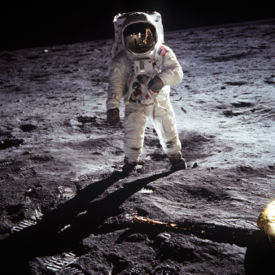
The Remote Control Unit controls on Armstrong's chest prevented him from seeing his feet. While climbing down the nine-rung ladder, Armstrong pulled a D-ring to deploy the Modular Equipment Stowage Assembly (MESA) folded against Eagle's side and activate the TV camera. The first images used a Slow-scan television system which was incompatible with commercial broadcast technology at the time so the images rebroadcasted were played on screens mounted in front of conventional television cameras. The signal was picked up at Goldstone in the USA but with better fidelity by Honeysuckle Creek Tracking Station in Australia. Minutes later the TV was switched to normal television, and the feed was switched to the more sensitive radio telescope station at the Parkes Observatory in Australia. Despite some technical and weather difficulties, ghostly black and white images of the first lunar EVA were received and were immediately broadcast to at least 600 million people on Earth.
After describing the surface dust ("fine and powdery ... I only go in a small fraction of an inch, but I can see the footprints of my boots"), Armstrong stepped off Eagle's footpad and into history as the first human to set foot on another world, famously describing it as "one small step for (a) man, one giant leap for mankind." He reported that moving in the Moon's gravity, one-sixth of Earth's, was "even perhaps easier than the simulations ... It's absolutely no trouble to walk around".
In addition to fulfilling President John F. Kennedy's mandate to land a man on the Moon before the end of the 1960s, Apollo 11 was an engineering test of the Apollo system; therefore, Armstrong snapped photos of the LM so engineers would be able to judge its post-landing condition. He then collected a contingency soil sample using a sample bag on a stick. He folded the bag and tucked it into a pocket on his right thigh. He removed the TV camera from the MESA, made a panoramic sweep, and mounted it on a tripod 12 m (40 ft) from the LM. The TV camera cable remained partly coiled and presented a tripping hazard throughout the EVA.
Aldrin joined him on the surface and tested methods for moving around, including two-footed kangaroo hops. The PLSS backpack created a tendency to tip backwards, but neither astronaut had serious problems maintaining balance. Loping became the preferred method of movement. The astronauts reported that they needed to plan their movements six or seven steps ahead. The fine soil was quite slippery. Aldrin remarked that moving from sunlight into Eagle's shadow produced no temperature change inside the suit, though the helmet was warmer in sunlight, so he felt cooler in shadow.
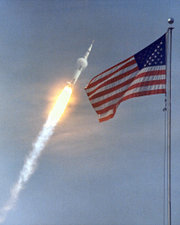
Together the astronauts planted the U.S. flag, then took a phone call from President Richard Nixon.
The MESA failed to provide a stable work platform and was in shadow, slowing work somewhat. As they worked, the moonwalkers kicked up gray dust which soiled the outer part of their suits, the integrated thermal meteoroid garment.
They deployed the EASEP, which included a passive seismograph and a laser ranging retroreflector. Then Armstrong loped about 120 m (400 ft) from the LM to snap photos at the rim of East Crater while Aldrin collected two core tubes. He used the geological hammer to pound in the tubes - the only time the hammer was used on Apollo 11. The astronauts then collected rock samples using scoops and tongs on extension handles. Many of the surface activities took longer than expected, so they had to stop documented sample collection halfway through the allotted 34 min.
During this period Mission Control used a coded phrase to warn Armstrong that his metabolic rates were high and that he should slow down. He was moving rapidly from task to task as time ran out. Rates remained generally lower than expected for both astronauts throughout the walk, however, so Mission Control granted the astronauts a 15-minute extension.
Lunar ascent and return
Aldrin entered Eagle first. With some difficulty the astronauts lifted film and two sample boxes containing more than 22 kg (48 lb) of lunar surface material to the LM hatch using a flat cable pulley device called the Lunar Equipment Conveyor. Armstrong then jumped to the ladder's third rung and climbed into the LM. After transferring to LM life support, the explorers lightened the ascent stage for return to lunar orbit by tossing out their PLSS backpacks, lunar overshoes, one Hasselblad camera, and other equipment. They then repressurised the LM, and settled down to sleep.
While moving in the cabin Aldrin accidentally broke the circuit breaker that armed the main engine for lift off from the moon. There was initial concern this would prevent firing the engine, which would strand them on the moon. Fortunately a felt-tip pen was sufficient to activate the switch. Had this not worked, the Lunar Module circuitry could have been reconfigured to allow firing the ascent engine.
After about seven hours of rest, they were awoken by Houston to prepare for the return flight. Two and a half hours later, at 17:54 UTC, they lifted off in Eagle's ascent stage, carrying 21.5 kilograms of lunar samples with them, to rejoin CMP Michael Collins aboard Columbia in lunar orbit.
After more than 2½ hours on the lunar surface, they had left behind scientific instruments such as a retroreflector array used for the Lunar Laser Ranging Experiment. They also left an American flag and a plaque (mounted on the LM Descent Stage ladder) bearing two drawings of Earth (of the Western and Eastern Hemispheres), an inscription, and signatures of the astronauts and Richard Nixon. The inscription read Here Men From Planet Earth First Set Foot Upon the Moon, July 1969 A.D. We Came in Peace For All Mankind.
Film taken from the LM Ascent Stage upon liftoff from the moon reveal the American flag, planted some 25 feet from the descent stage, whipping violently in the exhaust of the ascent stage engine. As the landing site receded out of the camera field of view, the flag appeared ready to topple, but whether it did in fact fall or not is unknown. Subsequent Apollo missions usually planted the American flags at least 100 feet from the LM to avoid being blown over by the ascent engine exhaust.
After rendezvous with Columbia, Eagle was jettisoned and left in lunar orbit. Later NASA reports mentioned that Eagle's orbit had decayed resulting in it impacting in an "uncertain location" on the lunar surface.
The astronauts returned to earth on July 24, welcomed as heroes. The splashdown point was , 2,660 km (1,440 nm) east of Wake Island, or 380 km (210 nm) south of Johnston Atoll, and 24 km (15 mi) from the recovery ship, USS Hornet. After recovery by helicopter approximately one hour after splashdown, the astronauts were placed in a trailer that had been designed as a quarantine facility. President Nixon was aboard the recovery vessel to personally welcome the astronauts back to Earth.

The astronauts were placed in quarantine after their landing on the moon due to fears that the moon might contain undiscovered pathogens, and that the astronauts were exposed to them during their moon walks. However, after almost three weeks in confinement (first in their trailer and later in the Lunar Receiving Laboratory at the Lyndon B. Johnson Space Centre), the astronauts were given a clean bill of health. On August 13, 1969, the astronauts exited quarantine to the cheers of the American public. Parades were held in their honour in New York, Chicago, and Los Angeles on the same day.
That evening in Los Angeles there was an official State Dinner to celebrate Apollo 11, attended by Members of Congress, 44 Governors, the Chief Justice, and ambassadors from 83 nations. President Nixon and Vice President Spiro T. Agnew honored each astronaut with a presentation of the Presidential Medal of Freedom. This celebration was the beginning of a 45-day "Giant Leap" tour that brought the astronauts to 25 foreign countries and included visits with prominent leaders such as Queen Elizabeth II of the United Kingdom. Many nations would honour the first moon landing by issuing Apollo 11 commemorative postage stamps or coins.
On September 16, 1969, the three astronauts spoke before a Joint Session of Congress on Capitol Hill. They presented two U.S. flags, one to the House of Representatives and the other to the Senate, that had been carried to the surface of the moon with them.
The command module is displayed at the National Air and Space Museum, Washington, D.C.. It is placed in the central exhibition hall in front of the Jefferson Drive entrance, and shares the main hall with other pioneering flight vehicles such as the Spirit of St. Louis, the Bell X-1, the North American X-15, Mercury capsule Friendship 7, and Gemini 4. The quarantine trailer is displayed at the Smithsonian's Udvar-Hazy Centre annex near Washington Dulles International Airport in Virginia.
Communications link
Early in the planning of Project Apollo, NASA decided to combine all communications between spacecraft and Earth into a single multiplexed feed called 'The Unified S-Band System', including audio communications, television images, crew medical telemetry and the spacecraft systems telemetry.
The signal was picked up by three purpose-built stations, called Goldstone (California), Honeysuckle Creek (Australia) and Fresnedillas (Spain), and backed-up by the three nearby deep space network stations (known as 'wing stations'). All of the signals were routed to NASA's communications centre (now the Goddard Space Flight Centre) in Greenbelt, Maryland.
Intelsat satellites began taking over the trans-oceanic transmissions toward the end of the 1960s, and NASA ended its contracts for the submarine telephone circuits, which were then reallocated by telephone administrations for normal voice use.
On 14 July 1969, two days before last day of the launch window, the INTELSAT III satellite over the Atlantic failed, cutting off the link between the dish in Spain and Greenbelt, Maryland. It was decided that the problem needed to be fixed by two hours before launch time, or the launch would be scrubbed - potentially the last launch opportunity in 1969.
The Early Bird satellite was activated, but there were concerns that it might not have enough power to get a signal to the United States. So, with great difficulty, twelve undersea telephone circuits were made available to NASA from six countries, for their inverse multiplexed signal. An official with the Spanish communications authority helped the team secure the circuits with his own personal list of contacts. The last circuit using inverse multiplexing was accepted by NASA just minutes before the time limit.
Conspiracy theories
There are allegations that the Apollo 11 moon landing was faked by NASA and possibly members of other involved organizations. A number of groups and individuals have advanced alternate historical narratives which tend, to varying degrees, to include the following common elements:
- The Apollo astronauts did not land on the Moon;
- NASA and possibly others intentionally deceived the public into believing the landing[s] did occur by manufacturing, destroying, or tampering with evidence, including photos, telemetry tapes, transmissions, and rock samples;
- NASA and possibly others continue to actively participate in the conspiracy to this day.
According to a 1999 poll conducted by the The Gallup Organization, 6% of the American public believes the landing was faked, while what Gallup termed an "overwhelming majority", some 89%, did in fact occur. The hoax claims are widely dismissed as baseless by mainstream scientists, technicians and engineers, as well as by NASA, and have been widely analyzed by debunkers such as Phil Plait.
Mission insignia
The familiar patch of Apollo 11 was designed by Collins, who wanted a symbol for "peaceful lunar landing by the United States". He picked an eagle as the symbol, put an olive branch in its beak, and drew a moon background with the earth in the distance. (Collins drew the light shining on the earth from the wrong direction; it would have shone from the top of the patch.) NASA officials said the talons of the eagle looked too "warlike" and after some discussion, the olive branch was moved to the claws. The crew decided the Roman numeral XI would not be understood in some nations and went with Apollo 11; they decided not to put their names on the patch to "allow it to symbolize everyone who worked on the moon landing". All colors are natural, with blue and gold borders around the patch. The LM was named Eagle to match the insignia. When the Eisenhower silver dollar was revived a few years later, the patch design provided the eagle for the back of the coin; the design was kept for the smaller Susan B. Anthony dollar.
Contingency television address
A speech titled " In Event of Moon Disaster" was prepared by William Safire for President Nixon to read on television in the event the Apollo 11 astronauts were stranded on the Moon. Following this address, radio communications with the moon would have been cut off, the astronauts left alone to die, while a clergyman was to commend their souls to "the deepest of the deep" in the fashion of a burial at sea.
